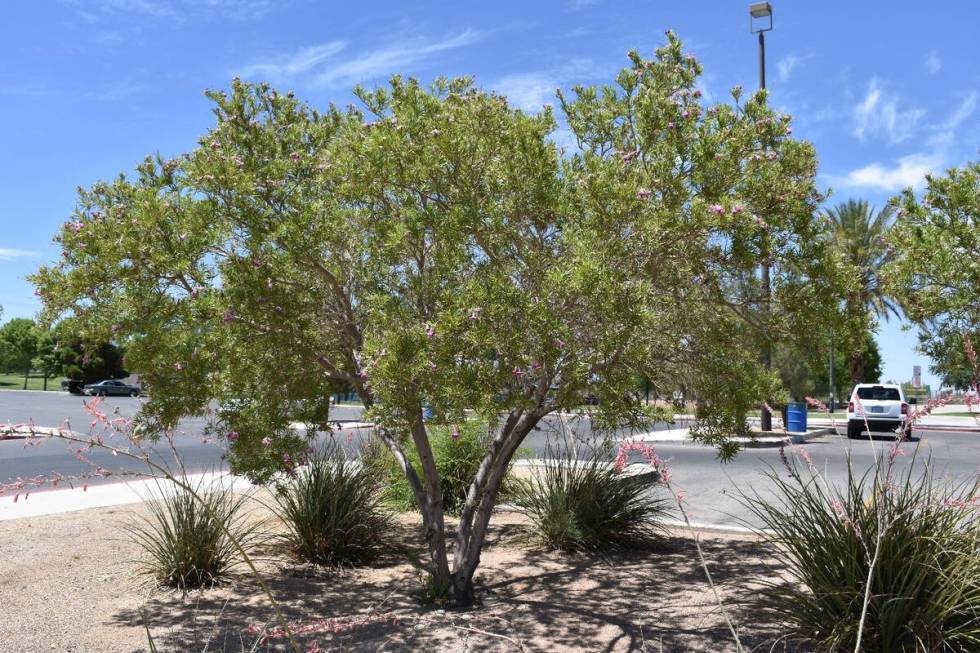Keep water use in mind when planning your landscape

Q: After this brutal summer heat, we plan to redo our home landscaping. Could you recommend some replacements for damaged or destroyed landscape plants that are more heat tolerant?
A: Anywhere from 60 percent to 70 percent of a home’s total water use occurs outside. You can decrease that water consumption by reducing the number of plants you use, decreasing their size and planting only desert-adapted plants.
A good list is available from the Southern Nevada Water Authority. A few of the plants mentioned are available locally. Otherwise, you will have to order them online (this winter for an early spring delivery).
Remember to select the tree based upon whether it survives here (winter low temperature). Match its mature size with your home (big trees require more water than smaller trees).
Investigate the rebate program at SNWA.com to see if these plants qualify with your plans.
When replacing plants, remember that the number and size of living plants determines your landscape water use and is reflected in your water bill.
Keep or replace plants that shade the sun-rich south and west walls and windows of your house. If you have a one-story home, use the smallest shrubs or trees (in mature height) you can find, to keep water usage lower.
Also consider additions (paint the walls, build gazebos, install nightlights) that don’t use water when replacing plants — most landscapes are overplanted.
Q: I have a Desert Museum palo verde that is less than 6 months old. It was planted in early spring. It has a few small water drips. Once a week I give it a heavy drink of water with a hose. Yesterday I noticed yellow sap on two trunks of the multi-trunk tree. I see no bugs or ants. Is this normal or do I have a problem? If it is a problem, how do I fix this?
A: Check how often your desert tree is being watered. In my experience, sap oozing from the trunk is normally an overwatering problem. I wish I could be more exact, but every soil is different.
There are two types of overwatering. When over-irrigating, you can give the plant too much water all at once or you can water too frequently. (It could also be both.) The tree might be swimming in water below the soil surface during the heat, but the surface looks dry. The tree can get around the first type, but death (from disease) usually accompanies watering when irrigating during the heat too often.
Water the tree deeply (where the roots are) but infrequently. During this heat, water the roots of this tree using a sprinkler (not flowing out of a hose), set weekly at 6 feet across. Run the sprinkler for 90 minutes.
If that is adequate during this heat, try 90 minutes at 10 days. Then two weeks. What you are doing is watering less often, but for the same number of minutes. It should take about two weeks to see if that way helps.
Q: I have a fertilizer tank attached to my irrigation system. It needs to be refilled, but I’m not sure if I should be fertilizing in this heat. Should I wait or fill it now?
A: Wait until it cools down below 100 degrees during the day. If you must fill it now, put the injector on its lowest setting. Most fertilizers are high in nitrogen (the first number on the bag) and are something like a 16-16-16. The first number is the worst fertilizer source that you can put on plants during the heat.
Q: How can I protect my garden from feral cats and using my garden’s soil as a bathroom?
A: Here are some costly ways to cat-proof a garden:
Install a fence that’s at least 6 feet high with an overhanging wire mesh to prevent cats from climbing over. You can also add over-climbing protection by attaching a net to metal poles that are bent upward and attached to the fence.
Other options include metal fencing with ball caps, PVC drain piping, or a roof made of wire mesh or PVC.
Some less-costly methods that might work:
■ Pine cones on the soil surface.
■ Stone mulch on the soil surface.
■ Plastic carpet runner with the spiky side up.
■ Chicken wire over the composted dirt area.
■ Plastic forks with the tines up.
■ Chopsticks.
■ Plastic plant stakes.
■ Cedar mulch covered with pine mulch and straw.
Bob Morris is a horticulture expert and professor emeritus of UNLV. Visit his blog at xtremehorticulture.blogspot.com. Send questions to Extremehort@aol.com.